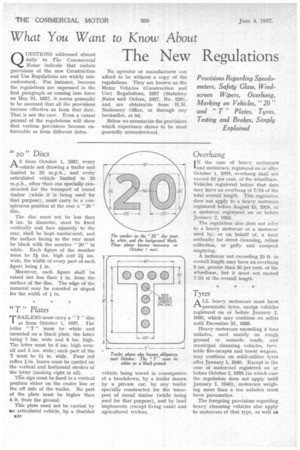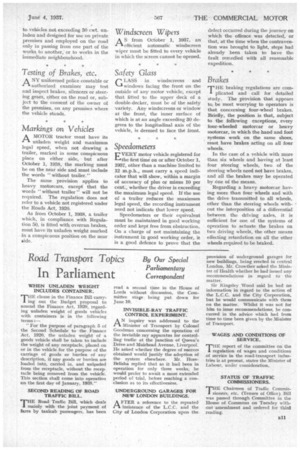What You Want to Know About
Page 44

Page 45

If you've noticed an error in this article please click here to report it so we can fix it.
The New Regulations
QUESTIONS addressed almost daily to The Commercial Motor indicate that certain provisions of the new Construction and Use Regulations are widely misunderstood. For instance, because the regulations are expressed in the first paragraph as coming into force on May 31, 1937, it seems generally to be assumed that all the provisions become effective as from that date. That is not the case. Even a casual perusal of the regulations will show that various provisions become enforceable as from different dates.
No operator or manufacturer can afford to be without a copy of the regulations. They are known as the Motor Vehicles (Construction and Use) Regulations, 1937 (Statutory Rules -and Orders, 1937, No. 229), and are obtainable from H.M. Stationery Office, or through any bookseller, at 8d.
Below we summarize the provisions which experience shows to be most generally misunderstood.
20" Discs A S from October 1, 1937, every vehicle not drawing a trailer and limited to 20 m.p.h., and every articulated vehicle limited to 20 m.p.h., other than one specially constructed for the transport of round timber (while it is being used for that purpose); must carry in a conspicuous position at the rear a "20 '! disc.
The disc must not be less than 8 ins, in diameter, must be fixed vertically and face squarely to the rear, shall be kept-unobscured, and the surface facing to the rear must be Mack with the number " 20 " in white. Each figure of the number must be si ins, high and 2i ins. wide, the width of every part of each figure being g in.
-Moreover, each figure shall be
raised not less than in. from the surface of the disc. The edge of the numeral may be rounded or sloped for the width of I in.
" T " Plates
TRAILERS must carry a " T " disc I as from October 1, 1937. The letter " T " must be white and mounted on a black plate, the latter being 7 ins, wide and 8 ins. high. The letter must be 6 ins, high overall and 5 ins. wide ; each part of the T must be 1/ in. wide. Four red reflex fin, lenses must be carried on the vertical and horizontal strokes of the letter (making eight in all).
Triis sign must be fixed in a vertical position either on the centre line or the off side of the trailer. No part of the plate must be higher than 4 ft. from the ground.
This plate need not be carried by an articulated vehicle, by a disabled vehicle being towed in consequence of a breakdown, by a trailer drawn by a private car, by any trailer specially constructed for the transport of round timber (while being used for that purpose), and by land implements (except living vans) and agricultural trailers.
Overhang
IN the case of heavy motorcars and motorcars, registered on or after October 1, 1938, overhang shall not elceed 50 per cent. of the wheelbase. Vehicles registered before that date may have an overhang of 7/24 of the total overall length. This regulation does not apply to a heavy motorcar registered before August 15, 1928, or a motorcar, registered on or before January 2, 1933.
The regulation also does not reffT to a heavy motorcar or a motorcar used by, or on behalf of, a local authority for street cleansing, refuse collection, or gully and cesspool emptying.
A motorcar not exceeding 20 ft. in overall length may have an overhang 9 ins: greater than 50 per cent. of the wheelbase, but it must not exceed 7/24 of the overall length.
• Tyres
ALL heavy motorcars must have pneumatic tyres, except vehicles registered on or before January 2, 1933, which may continue on solids until December 31, 1939.
Heavy motorcars exceeding 4 tons unladen, used mainly on rougn ground or unmade roads, and municipal cleansing vehicles, turn. table fire-escapes and tower wagons, may continue on solid-rubber tyres after January 1, 1940. Except in the case of motorcars registered on or before October 2, 1933 (in which case the regulation does not apply until January 1, 1940), motorcars weighing more than a ton unladen must have pneumatics.
The foregoing provisions regarding heavy cleansing vehicles also apply to motorcars of that type, as well a3 to vehiclesnot exceeding 30 cwt. unladen and designed for use on private premises and employed on the road only in passing from one part of the works to another, or to works in the immediate neighbourhood.
Testing of Brakes, etc.
ANY uniformed police constable or authorized examiner may test and inspect brakes, silencers or steering gears, either on the road or, subject to the -consent of the owner of the premises, on any premises where the vehicle stands.
Markings on Vehicles
AMOTOR tractor must have its unladen weight and maximum legal speed, when not drawing a trailer, marked in some conspicuous place on either side, but after October 1, 1938, the marking must be on the near side and must include the words "without trailer."
The same provision applies to heavy motorcars, except that the words "without trailer" will not be required. The regulation does not refer to a vehicle not registered under the Roads Act, 1920.
As from October 1, 1938, a trailer which, in compliance with Regulation 50, is fitted with overrun brakes, must have its unladen weight marked
• in a conspicuous position on the near side.
Windscreen Wipers
AS from October 1, 1937, an efficient automatic windscreen wiper must be fitted to every vehicle in which the screen cannot he opened.
Safety Glass
GLASS in windscreens and windows facing the front on the outside of any motor vehicle, except that fitted to the upper deck of a double-decker, must be of the safety variety. Any windscreens or window at the front, the inner surface of which is at an angle exceeding 30 degrees to the longitudinal axis of the vehicle, is deemed to face the front.
Speedometers
EVERY motor vehicle registered for the first time' on or after October 1, 1937, other than a machine limited to 12 m.p.h., must carry a speed indicator that will show, within a margin of accuracy of plus or minus 10 per cent., whether the driver is exceeding the maximum legal speed. If the use of a trailer reduces the maximum legal speed, the recording instrument need not indicate that lower speed.
Speedometers or their equivalent must be maintained in good working order and kept free from obstruction. On a charge of not maintaining the instrument in good working order, it is a good defence to prove that the defect occurred during the journey on which the offence was detected, or that, at the time when the contravention was brought to light, steps had already been taken to have the fault remedied with all reasonable expedition.
Brakes
THE braking regulations are com▪ plicated and call for detailed study. The provision that appears to be most worrying to operators is that concerning four-wheel brakes. Briefly, the position is that, subject to the following exceptions, every four-wheeled motorcar or heavy motorcar, in which the hand and foot systems work on the same shoes, must have brakes acting on all four wheels.
In the case of a vehicle with more than six wheels and having at least four steering wheels, two of the steering wheels need not have brakes, and all the brakes may be operated by one of the means.
Regarding a heavy motorcar having more than four wheels and with the drive transmitted to all wheels, other than the steering wheels without the interposition of a differential between the driving axles, it is sufficient for one of the systems of operation to actuate the brakes on two driving wheels, the other means effecting retardation on all the other wheels required to be braked.




























































































